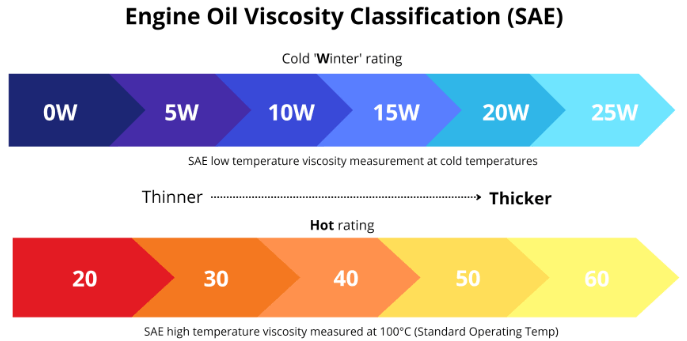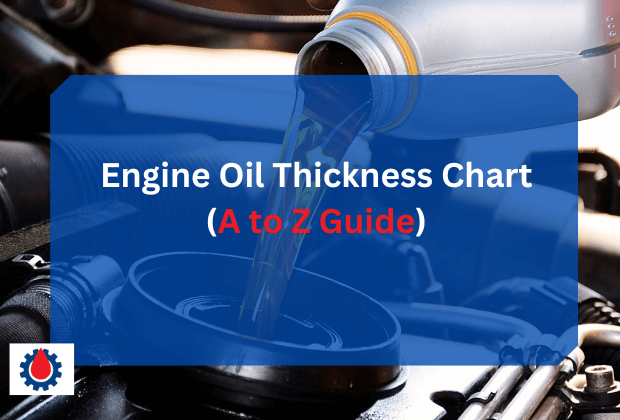One of the key aspects of engine oil is its viscosity or “thickness,” which determines how well it flows at different temperatures. Understanding the engine oil thickness chart is essential for selecting the right oil for your vehicle, ensuring optimal lubrication and engine protection.
In this post, we’ll cover everything you need to know about engine oil thickness, including viscosity ratings, how to read SAE oil grades, and a detailed engine oil thickness chart in a table format.

Engine Oil Thickness Chart
| SAE Grade | Viscosity at 40°C (cSt) | Viscosity at 100°C (cSt) | Recommended Temperature Range | Best Use Cases |
|---|---|---|---|---|
| 0W-20 | 35-45 | 8-9 | -35°C to 30°C | Fuel-efficient cars, hybrid vehicles, modern engines |
| 5W-20 | 40-50 | 8-9 | -30°C to 30°C | Cold climates, newer engines, fuel economy |
| 5W-30 | 50-65 | 9.3-12 | -30°C to 35°C | Most modern cars, all-season use |
| 10W-30 | 60-75 | 9.3-12 | -25°C to 40°C | Older engines, moderate climates |
| 10W-40 | 90-100 | 12.5-16 | -25°C to 45°C | High-mileage vehicles, warmer climates |
| 15W-40 | 100-130 | 12.5-16 | -20°C to 50°C | Diesel engines, commercial trucks, hot climates |
| 20W-50 | 150-170 | 16-21 | -15°C to 55°C | Racing engines, older engines, heavy loads |
| 0W-40 | 70-80 | 12.5-16 | -40°C to 50°C | Extreme cold and hot weather, high-performance engines |
| 5W-40 | 80-100 | 12.5-16 | -30°C to 50°C | Turbocharged engines, performance cars |
| 10W-60 | 160-180 | 21-26 | -20°C to 60°C | Sports cars, racing applications |
Read Engine Oil Temperature Chart(Complete Guide)
What Is Engine Oil Thickness?
Engine oil thickness, also known as viscosity, refers to how easily the oil flows at different temperatures. It is classified into two main categories:
- Low-viscosity oil (thinner oil): Flows easily, ideal for cold weather.
- High-viscosity oil (thicker oil): Provides better lubrication at high temperatures.
SAE Viscosity Grades Meaning
The Society of Automotive Engineers (SAE) developed a grading system for engine oil thickness. The numbers in the SAE viscosity grade indicate the oil’s flow characteristics at different temperatures.
For example, 10W-30 means:
- 10W: Cold temperature viscosity (lower numbers flow better in the cold).
- 30: Hot temperature viscosity (higher numbers provide better protection at high temperatures).
The W in the rating stands for “Winter,” indicating the oil’s performance in cold conditions.
Read Engine Oil Capacity Chart(Guide Model A to Z)
Choosing the Right Oil Thickness for Your Engine
- Climate: Use lower viscosity (e.g., 0W-20) for cold climates and higher viscosity (e.g., 20W-50) for hot climates.
- Vehicle Type: Newer cars usually require thinner oils (e.g., 5W-30), while older vehicles and heavy-duty engines benefit from thicker oils (e.g., 15W-40).
- Manufacturer Recommendations: Always check the owner’s manual for the recommended oil grade.
- Driving Conditions:
- City driving & short trips: Thinner oils provide better lubrication.
- Highway driving & towing: Thicker oils protect against heat and wear.
- Engine Age & Wear: Older engines with wear and tear benefit from higher viscosity oils.
Read Oil Drain Plug Torque Chart(Vehicles A to Z)
FAQs
Which oil is thicker, 5W30 or 10W30?
Both 5W-30 and 10W-30 have the same viscosity at high temperatures (30-weight viscosity at 100°C). However, 10W-30 is thicker in cold temperatures than 5W-30 because the first number (before the “W”) represents the oil’s winter (cold) viscosity.
- 5W-30: Flows better in cold weather.
- 10W-30: Slightly thicker when cold but performs the same at high temperatures.
If you live in a cold climate, 5W-30 is better.
Is 15W-40 oil thicker than 10W-30?
Yes, 15W-40 is thicker than 10W-30 in both cold and hot temperatures.
- 15W-40 has a higher viscosity in cold weather (15W vs. 10W) and a 40-weight viscosity at high temperatures, making it thicker overall.
- 10W-30 is thinner, which helps in colder climates and can improve fuel economy.
Use 15W-40 for heavy-duty engines, older engines, or hot climates.
Read Car Engine Oil Color Chart(Color That Signals Immediate Danger)
Which oil is thicker, 10W30 or 10W40?
10W-40 is thicker than 10W-30 at high temperatures.
- Both oils have the same cold-start viscosity (10W).
- 10W-40 maintains a thicker film at high temperatures, providing extra protection for engines under heavy loads or in hot climates.
10W-40 is preferred for high-performance engines or older vehicles that need extra lubrication.
Which oil is thicker, 5W30 or 20W50?
20W-50 is much thicker than 5W-30.
- 5W-30 is thinner at cold and hot temperatures, making it suitable for modern engines and cold climates.
- 20W-50 is significantly thicker, providing more protection for high-performance, high-mileage, or heavily loaded engines.
Using 20W-50 instead of 5W-30 in a modern engine can reduce fuel efficiency and cause wear.
Read Engine Oil Additives to Stop Ticking Lifter(Top 5 Best Oil)
What happens if I put 10W40 instead of 10W30?
Using 10W-40 instead of 10W-30 will result in slightly thicker oil at high temperatures.
Pros:
- Provides better protection in hot climates or high-load conditions.
- May reduce oil consumption in older engines.
Cons:
- Could reduce fuel efficiency slightly.
- May cause slower oil circulation in very cold weather.
If your engine allows 10W-40 as an alternative to 10W-30, it’s generally safe to use.
Is 10W40 better than 15W40?
It depends on the application:
- 10W-40 flows better in colder temperatures (better cold-start performance).
- 15W-40 is slightly thicker when cold, making it more suitable for diesel engines and heavy-duty applications.
If you live in a cold climate, 10W-40 is better. If you’re using it in a truck, diesel engine, or warm climate, 15W-40 may be better.
Read How Does Triax Engine Repair Oil Work(Save Your Engine and Wallet)
Is 15W40 good for older engines?
Yes, 15W-40 is great for older engines, especially high-mileage ones.
- Thicker oil reduces leaks and burning in worn-out engines.
- Provides better engine protection under heavy load or high heat.
- Commonly used in diesel engines and older gasoline engines.
However, ensure your engine is designed for 15W-40, as using it in a modern engine designed for 5W-30 or 10W-30 could cause problems.
What happens if I use 15W50 instead of 10W40?
Using 15W-50 instead of 10W-40 means:
Pros:
- Thicker oil film for better protection at high temperatures.
- Better suited for high-performance and high-mileage engines.
- Ideal for racing engines, motorcycles, and extremely hot climates.
Cons:
- Poor cold-start performance in colder temperatures.
- Reduced fuel efficiency due to higher resistance.
- Potential engine wear in modern engines designed for thinner oils.
Use 15W-50 only if your engine is designed for thicker oil or operates in extreme conditions.
Read Racing Engine Oil Viscosity(Learn the Viscosity Formula for Success)
What is the advantage of 10W40 oil?
10W-40 has several benefits, including:
- Versatile for moderate to hot climates.
- Better protection at high temperatures compared to 10W-30.
- Ideal for older or high-mileage engines that require thicker oil.
- Prevents excessive oil consumption in aging engines.
It is commonly used in motorcycles, heavy-duty vehicles, and some high-performance cars.
Final word
An engine oil thickness chart is essential for choosing the right oil for your vehicle. The correct viscosity ensures smooth engine operation, better fuel efficiency, and long-term durability.




